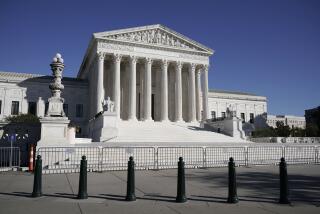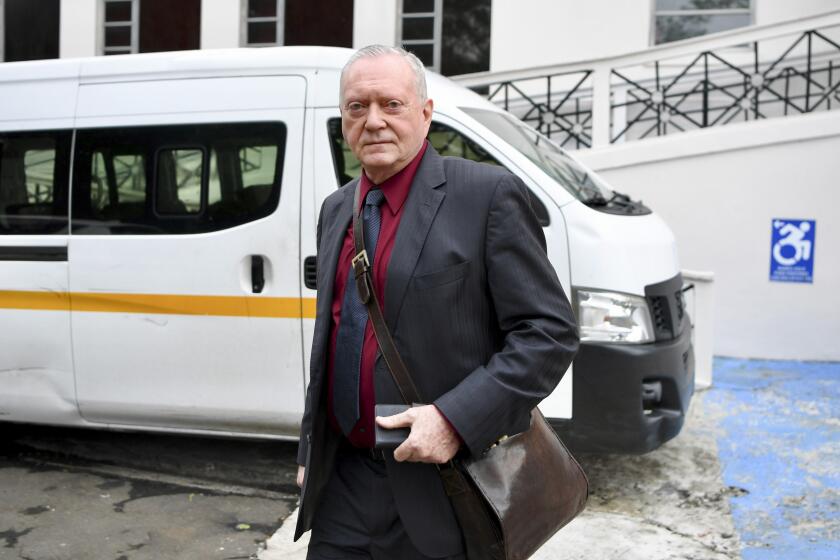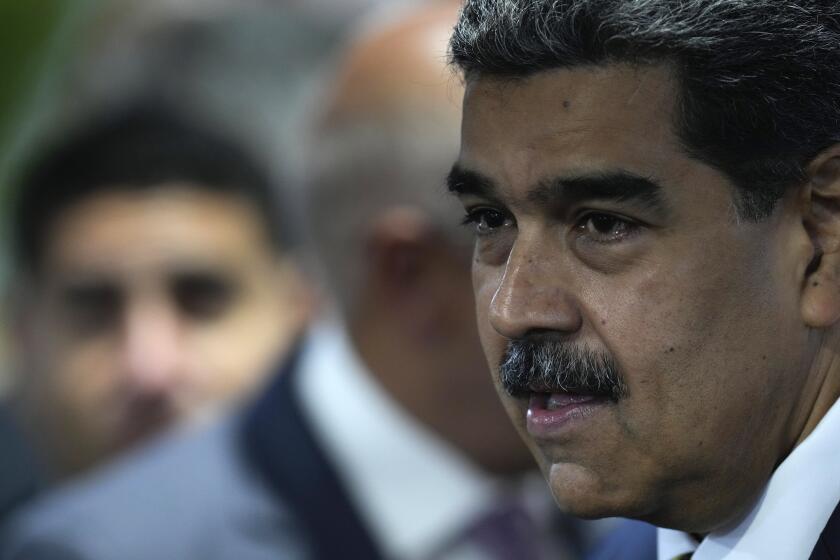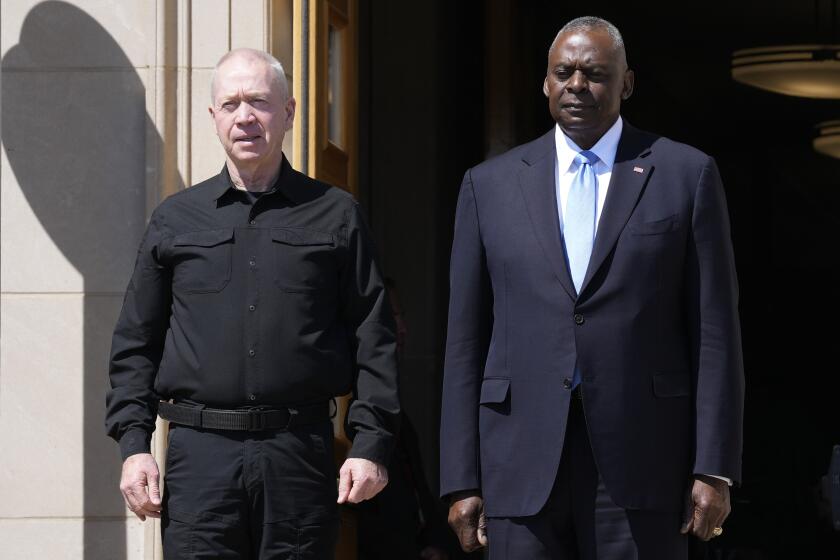Seagal Testifies, Explains His Ties to Mob Family
The good news was, Steven Seagal had them waiting in line again to see him, behind a velvet rope no less.
The bad news was, they came to see him in the last place he wanted to be, in court, on a witness stand, testifying against reputed members of a mob crew charged with all sorts of racketeering along the New York waterfront -- and trying to extort hundreds of thousands of dollars from “an individual in the film industry,” which was him.
Seagal came to Brooklyn a dozen years ago to make one of the movies that made him famous, “Out for Justice,” in which he dispatched menacing mob wise guys one after another, with his fists, feet and a pool cue. But on Tuesday, when it was time for the hulking tough-guy actor to talk about his real-life encounters with such characters, he chose a most undramatic word -- “uncomfortable.”
That was how he felt, he said, when they came to see him in Toronto in October 2000, while he was making “Exit Wounds,” then again the next February, when they led him to a private dining room in a Brooklyn restaurant for a meeting with the Mafia captain, even though he himself was armed, as usual, and had a bodyguard nearby.
And it was the same when they visited him in Los Angeles, coming to his home the morning of the “Exit Wounds” premiere, except by then he was “increasingly uncomfortable,” he said.
What Seagal never said explicitly during his day on the witness stand was that he was afraid. When he explained why he never turned to law enforcement when he faced the weight of mob muscle, he put it partly in terms of his career. You can’t make movies, he noted, “in the witness protection program.”
Until Tuesday, there had been plenty of empty seats in the courtroom of U.S. District Judge Frederic Block, who for the last month has been hearing the case of U.S. vs. Gotti. There are three Gottis among the seven defendants, but this is one mob trial without a single act of violence, much less a murder.
Of the 67 counts in the indictment, 65 deal with the less sexy crimes along the waterfront, where mob captain Anthony “Sonny” Ciccone is accused of calling the shots in the longshoremen’s union, collecting payoffs from workers and trucking firms, and sending envelopes of cash up the crime family ladder to the Gottis.
Tuesday was the day to hear the government’s evidence on the other two counts, however, and the spectators filled every space on the court benches to hear the witness described in court papers as “John Doe 5.”
One of the first to grab a seat was 65ish “Margie the Court Buff,” who has been to every major New York mob trial since the late John Gotti’s first, in 1986.
Now, his brother Peter walked from the lockup to the defense table, giving a “Good morning” to the press rows and asking a court artist, “How do you like my tie?” It was gold.
So was Seagal’s silk shirt, though a brown silk jacket mostly covered it. Whereas other witnesses have come through the public part of the courtroom, he entered from the back, through the door used by jurors, near the judge’s seat.
He was in blue jeans and had a red beaded bracelet wound around his left wrist. His jet-black hair was pulled back in his trademark style.
He spoke so softly at first, Block had to tell him to speak up. “Just sit back, relax,” the judge said.
Seagal took a deep breath and told the prosecutor, Assistant U.S. Atty. Andrew Genser, “I’m an actor, producer, director and musician.” Seagal explained how he had become an expert not only in martial arts, but firearms, and he sometimes instructed law enforcement officials. Did he carry a gun? “All the time.”
“You don’t have it on you now, do you?” the judge quipped.
As good as he was with weapons, he was bad with numbers. That’s one reason he entered the partnership that landed him in this case, the actor said.
Early in his career, he met Julius Nasso, the Brooklyn-born pharmacist eager to get into the movie business. They formed Seagal-Nasso Productions and “became best friends,” Seagal said.
But by the mid-1990s, he said, Nasso went through a divorce and became “depressed and erratic and abusive” -- making him impossible to deal with. Seagal’s account was the flip side of the one Nasso has been giving for the last year.
The prosecution alleges that after the two men split from each other in 2000, Nasso sought help from an old friend, Ciccone.
Seagal said his first response was “let’s talk” when the reputed Gambino family mobster visited him in Toronto and said “it would be really nice” if he continued working with Nasso, and that someone else would appreciate it too -- “Jules’ mother.”
Seagal said one of those uncomfortable moments came after Ciccone asked him who he was “with.” Seagal said he replied, “I’m an actor, but I’m not with you.” That’s when “I thought there was a good possibility it was going to escalate into something else,” Seagal said.
He told of a similar moment at their subsequent sit-down in the Brooklyn restaurant, Gage & Tollner. The line he attributed to Ciccone there is almost right out of “Get Shorty”: “Look at me when you’re talking.”
The issue was money. Did he owe Nasso, or did Nasso owe him? At the meetings in Los Angeles, he said, the New York crowd gave him their answer: He owed $3 million. Seagal said he didn’t pay “because I didn’t owe it.” Tape transcripts submitted by the government quote Ciccone instructing Nasso -- who is to be tried separately in September -- to demand $150,000 per film from the actor.
Seagal said he was buying time, hoping they could work it out “like businessmen” and avoid “an ugly situation.” Explaining why he didn’t go to the FBI, he said that in a situation like that, “They can’t help me. They can’t protect me.”
Instead, he sought out another reputed mobster, Angelo Prisco, in a New Jersey prison, hoping he could be “a peacemaker,” he said.
When Prisco asked for legal help, he paid $10,000 to a lawyer, calling that a favor for a favor, and “only fair.”
Prosecutors have said they stumbled onto the situation through the bugs being used in their waterfront investigation. Seagal testified that he pleaded the 5th when he was first subpoenaed before a grand jury because he wanted “nothing to do with them, or this.”
He testified then, and now, only after being granted immunity.
Defense lawyers in the case had pledged to expose Seagal as a “pathological liar.” But the prosecutor brought up one matter the defense had threatened to use. He asked Seagal whether he was behind the June 2002 vandalism of the car of a Los Angeles Times reporter investigating his ties to Nasso and the mob. “No,” Seagal said.
On Tuesday, Ciccone’s lawyer, George Santangelo, quickly set out to provoke Seagal’s ire, first questioning why an innocent victim needed to plead the 5th, then asking whether Seagal had ever tried to hire an ex-CIA agent to kill someone. It worked. Seagal was soon waving his arms and declaring, “This is insane.... I’m not on trial here.” The judge told the lawyer to move on.
Under the defense scenario, Ciccone was not an enforcer extorting money from Seagal, but a mediator trying to settle the dispute between Seagal and his old partner.
Santangelo said the actor began claiming extortion only when Nasso filed a civil suit against him asking for $60 million in damages. He pressed Seagal loudly, “Who’d you tell?”
“You going to scream at me?” Seagal asked. “You want to play this game?”
The judge decided it was time for a break.
“Keep the volume down,” he said.
Later in the day, the actor issued a statement: “In the movies, I play a tough action hero, but I have feelings. I have been a victim twice: once, the victim of the crimes which are now on trial, once again as the victim of a vicious smear campaign aimed at discrediting me.”
But in court, when he asked the judge for permission to say one last thing, all he did is wave and say, “Thank you all.”
After Seagal was done, Margie, “the court buff,” gave Seagal a thumbs up, saying, “He keeps you entertained. I wish he made more movies.” Even Judge Block’s grandson was ready with a verdict after watching with his mom.
“I like his movies,” the kid said. “but I thought he’d be skinnier.”
More to Read
Start your day right
Sign up for Essential California for news, features and recommendations from the L.A. Times and beyond in your inbox six days a week.
You may occasionally receive promotional content from the Los Angeles Times.






